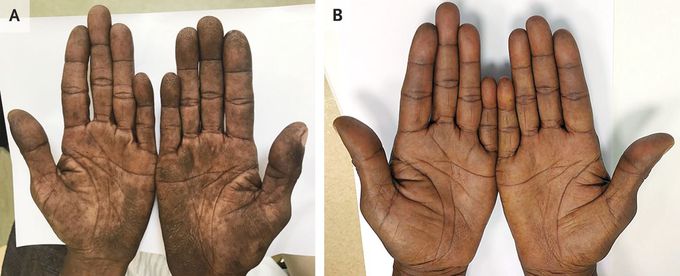


Tripe Palms
A 59-year-old woman with a 35-pack-year history of smoking tobacco presented to the clinic with a 5-month history of skin darkening on the palms. She reported no other symptoms. Physical examination showed velvety thickening of the skin on her palms and fingers, with accentuated fingerprint ridges, a finding known as tripe palms, or acanthosis palmaris (Panel A). There was also shortening of the small finger on both hands, a finding that was thought to be a normal variation. Neither clubbing nor acanthosis nigricans was present. Owing to concern for underlying cancer, computed tomography of the chest was performed, and a mass was observed in the upper lobe of the right lung. A biopsy specimen of the mass was obtained and revealed undifferentiated carcinoma. A right upper lobectomy was then performed, and moderately differentiated, invasive lung adenocarcinoma with metastases to regional lymph nodes was observed. Testing of the tumor for mutations was not available owing to resource limitations. Tripe palms — named for their resemblance to the gastric lining of ruminant animals — are a type of paraneoplastic dermatopathy seen most frequently in patients with adenocarcinoma of the lungs or the gastrointestinal tract. Cancer treatment may resolve this finding, as it did in this patient. After completion of a 5-month course of systemic chemotherapy, the skin changes had abated (Panel B).

